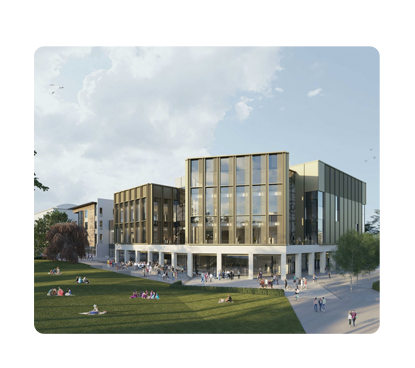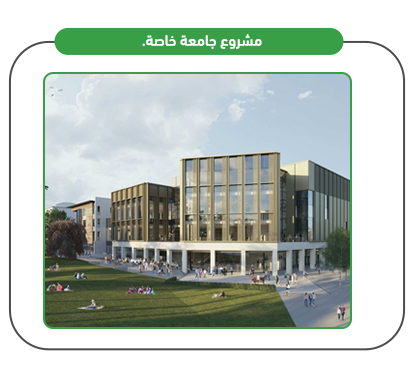Establishing a private university is a strategic investment in the higher education sector, aimed at meeting the evolving needs of the job market and the aspirations of students by offering a diverse and distinguished range of academic programs. The university features a modern, integrated educational environment, with advanced facilities such as state-of-the-art scientific laboratories, digital libraries, and classrooms equipped with the latest technological and educational tools. The university offers a broad spectrum of academic disciplines, including engineering, business administration, sciences, arts, humanities, and more, allowing students the freedom to choose fields that align with their interests and professional ambitions. It is committed to delivering high-quality education through distinguished academic staff and a team of experts in various fields. In addition, the university aims to enhance the student experience by offering academic support services and career counseling specifically designed to ensure their success and professional development.

The private university project aims to create a distinguished educational institution that focuses on innovation and scientific research as the foundation for academic excellence. The university seeks to attract talented students from around the world by offering scholarships and academic partnerships with leading international universities, enriching the educational experience and providing students with the opportunity to explore diverse cultures and expertise. The university emphasizes applied education through partnerships with industrial and commercial institutions to offer practical training programs that connect academic study with real-world applications, enhancing students’ readiness for the job market. The university also houses advanced research centers, such as innovation centers and technology incubators, designed to support research and develop innovative solutions to societal and technological challenges. In support of entrepreneurship, the university offers specialized programs to develop leadership skills among students and assist them in launching their own ventures. This project aims to build a comprehensive university that enhances education quality and prepares generations capable of making a positive and lasting impact on society.



Flexible and innovative curricula.
A learning environment tailored to meet individual needs.
Support for research and innovation, fostering cultural and intellectual diversity.
Distinctive academic guidance to help students choose the right career paths.
Attracting international students.
Integrating modern educational technologies such as virtual reality into the learning process.
Achieving sustainable financial returns by offering specialized educational programs and organizing training courses for individuals and organizations.
Executive summary
Study project services/products
Market Size Analysis
Risk Assessment
Technical study
Financial study
Organizational and administrative study

The Education Sector in GCC Countries
Because “Mashroo3k” Economic Consulting and Market Research Company believes in the importance of the education sector and its role in localizing national labor, it presents below the key indicators of the educational sector in GCC countries, thereby encouraging investment in this vital sector:
The total number of students in the Early Childhood Development stage (including nurseries and kindergartens) in GCC countries, according to the latest available statistics, reached 851.5 thousand students.
The number of school education students in the GCC was estimated at 9.3 million students (79.4% in the public sector and 20.6% in the private sector).
The number of adult education center learners was estimated at 181,247 students.
The number of higher education students was 2,206,446 students.
The number of early childhood education teachers was 50,647 teachers.
The number of school education teachers was estimated at 727,904 teachers.
There are 5,806 educational institutions operating at the early childhood stage.
There are 32,310 educational institutions operating at the school education stage.
Over the past years, governments in GCC countries have sought to bridge the gap between education and the labor market. They have adopted curricula that increase the share of vocational and technical education and encourage learning through modern media and technologies. It is also worth noting the increase in government spending by these six countries on education and its quality to graduate generations that meet the private sector’s labor needs.
According to the latest statistics:
Saudi Arabia spends 18.9% of its budget on education.
The UAE spends 14.8%.
Oman spends 12.2%.
Bahrain spends 9.8%.
Kuwait spends 12.3%.
Qatar spends 10.5% of its budget on education.
By the year 2023, the value of the private education market in GCC countries is expected to reach $26.2 billion.
The Global Education Sector:
The size of the global educational services market reached approximately $2,882.52 billion by the end of 2021, and global experts expect it to reach $3,191.79 billion by the end of 2022 — achieving a compound annual growth rate (CAGR) of 10.7%.
By 2026, the market value is projected to increase to $4,623.90 billion, achieving a CAGR of 9.7% over the forecast period.

By 2030, the global value of education as an industry is expected to reach $10 trillion USD.
By 2024, the global online education market is projected to reach $247.46 billion USD.
The AI-powered education market is expected to expand at a compound annual growth rate (CAGR) of 36% from 2022 to 2030.
In the year 2000, the number of pupils worldwide was approximately 657 million, and this number increased to 739 million by 2019.
In 2000, the number of secondary education students was around 452 million, rising to 601 million by 2019.